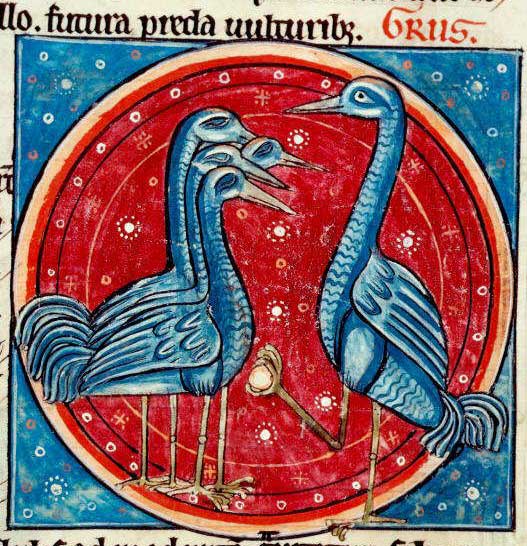In my new job as an addiction recovery chaplain, one of the first themes we have explored in chapel was that of the need for trust. For reasons that I think will need a book to work out, my own thoughts on this topic draw me continually to the subject of birds, in particular, sandhill cranes. This is a snippet of some draft notes for that book.
Most of my friends know by now of my deep and passionate love of a pair of sandhill cranes that reside in a marsh here in Medina County. I named them Gene and Grace (Kelly) for a number of reasons. Cranes are renowned for their remarkable dancing and for me the image of Gene Kelly dancing in the rain is one that fills me with great joy, especially knowing that he had a high fever on the day he shot that iconic dance scene. Also, one of my best friends in college, one who listened with amazing attentiveness to me as I struggled with my own wounds is also named Eugene, or Gene as we called him then. Naming animals is a tricky thing, but usually they have a way of letting you know if you’ve got it right.

Gene dancing up a storm
Grace lost the bottom part of her leg this spring in an accident and now relies even more upon her partner Gene to keep watch for her and the potential enemies she is less able to defend herself from. As I watched her bow down low on one leg to forage for food, I was struck by the gracefulness of her movements and the name Grace seems most fitting as I thought of the slow moving beauty and resilient strength of the iconic Grace Kelly.

Grace preening on one leg. How could she not be Grace?
Cranes are the oldest species of bird known. They have been revered by all cultures, civilizations, and religious traditions where they reside, including the Buddhist, native American, African, and Christian traditions.
Cranes typically mate for life and are fiercely loyal to one another. Both the male and female take time to sit on the nest while the other keeps guard and gets some food. Because Grace lost part of her leg this spring, they were unable to produce any offspring. Grace struggles somewhat to forage, and when she does, she is more vulnerable since she can’t use one of the bird’s best defenses, a strong kick. Gene is always by her side. Always. And when she bends down to eat, he is usually scanning the horizon for any threats. This is trustworthy love in action. We are all wounded in ways, but some are more vulnerable than others and one way to think of prayer or spiritual practice is as attentiveness to the vulnerable heart of another. This is Gene in action.

Gene on the lookout while Grace gets a breakfast of soybeans in a field near their marsh home
In the Christian tradition cranes are revered for their prayerful attentiveness. It was believed that, like monks in a monastery, or residential staff in a recovery center, it was crucial for there to be one or two cranes who stayed awake all night to insure the safety of the rest. Cranes are known for sleeping on one leg. In the medieval imagination, it was believed that the other leg held a large rock, symbolizing the rock of Christ, which, if the guardian bird were to accidentally fall asleep, would hit the ground with a loud thud and awaken the birds to their danger. These verses from the First Epistle of Peter were likely in the monks minds when the imagined the cranes this way:
Cast all your anxiety on him, because he cares for you. Be sober. Be Watchful. Your adversary the devil prowls around like a roaring lion, seeking someone to devour. Resist him, steadfast in your faith, for you know that your brothers and sisters in all the world are undergoing the same kinds of suffering.

Here are snippets from two sermons speaking of their qualities and an icon from a medieval Christian bestiary. Theologian birdwatchers have been drawn to their watchfulness, one of the most important qualities in a strong prayer life. Though their ornithological accuracy may be in doubt in the thoughts, Isidore and St. Antony are surely on to something by seeing that our own attentiveness to the virtues of natural world have much to teach us. By their faithful presence to one another day after day, Gene and Grace have taught me a great deal about how to be a trustworthy partner to those I love. And they have taught me one way to think about what it means to pray without ceasing.
Isidore of Seville [7th century CE] (Etymologies, Book 12, 7:14-15): Cranes (grues) take their name from the murmuring sound they make. When they are travelling somewhere they follow the letters of the alphabet. They fly at great altitude so they can see the lands they seek. The leader in flight maintains the line of birds with its voice; when it grows hoarse another bird takes its place. At night they take turns acting as guard; the one on duty holds a small stone in its claws to hold off sleep, and cries out at anything to be feared. Their age is revealed by their color, because the darken as they grow old.
St Antony of Padua [12th-13th century CE] (Sermons): Merciful men compared to cranes. Let us, therefore, be merciful, and imitate the cranes, who, when they set off for their appointed place, fly up to some lofty eminence, in order that they may obtain a view of the lands which they are going to pass. The leader of the band goes before them, chastises those that fly too slowly, and keeps together the troop by his cry. As soon as he becomes hoarse, another takes his place; and all have the same care for those that are weary; so that if any one is unable to fly, the rest gather together, and bear him up till he recovers his strength. Nor do they take less care of each other when they are on the ground. They divide the night into watches, so that there may be a diligent care over all. Those that watch hold a weight in one of their claws, so that, if they happen to sleep, it falls on the ground and makes a noise, and thus convicts them of somnolency. Let us, therefore, be merciful as the cranes; that, placing ourselves on a lofty watch-tower in this life, we may look out both for ourselves and for others, may lead those that are ignorant of the way, and may chastise the slothful and negligent by our exhortations. Let us succeed alternately to labour. Let us carry the weak and infirm, that they faint not in the way. In the watches of the night, let us keep vigil to the Lord, by prayer and contemplation.
Leave a comment